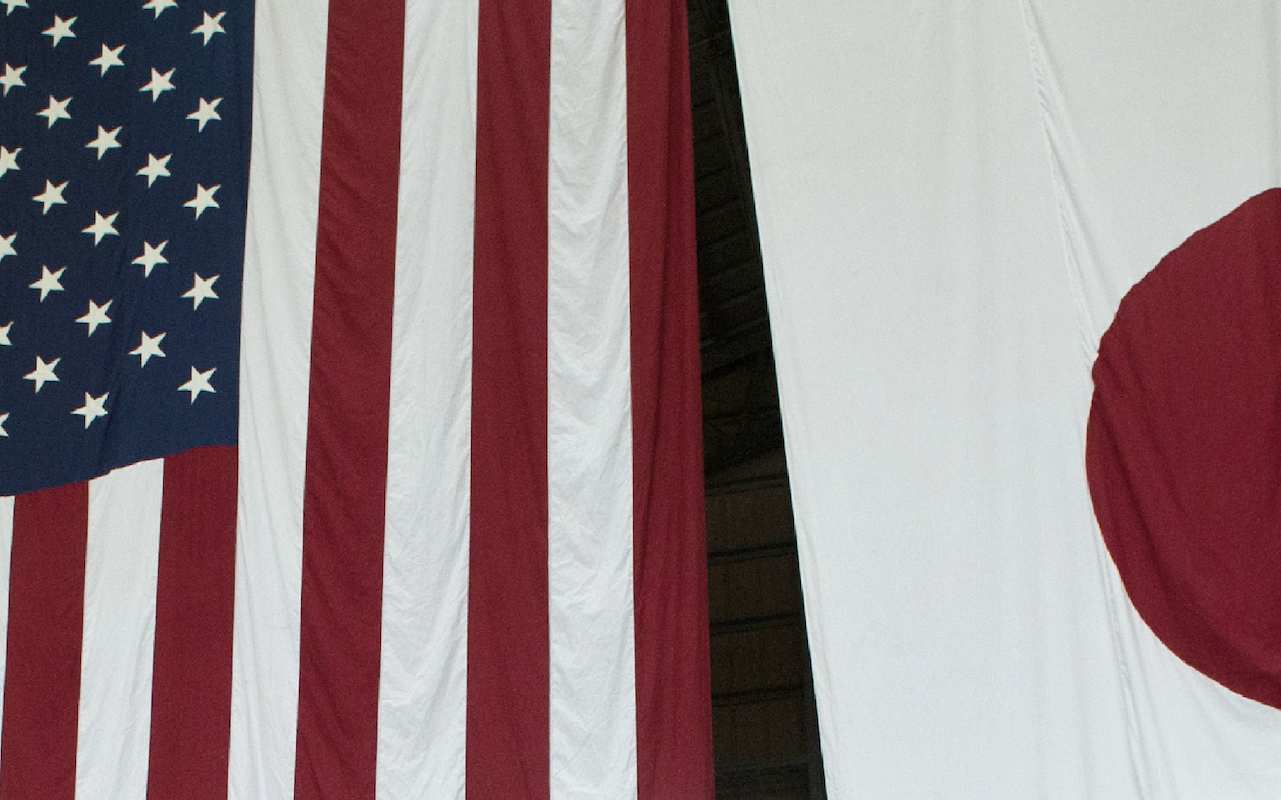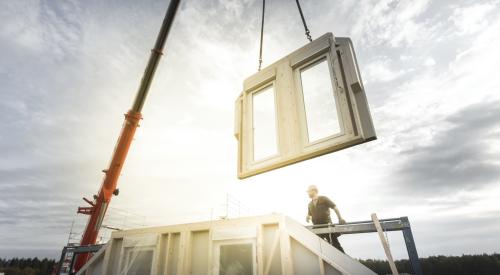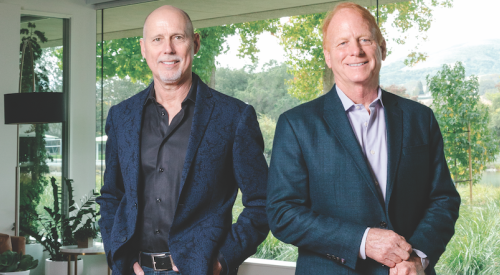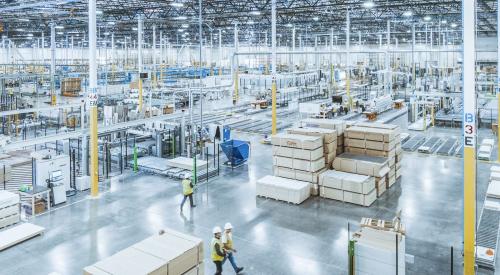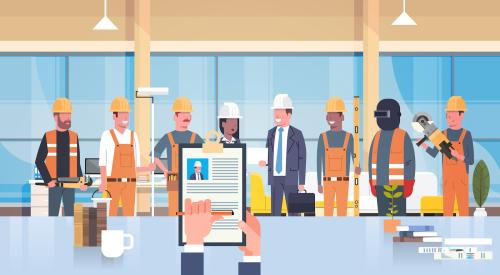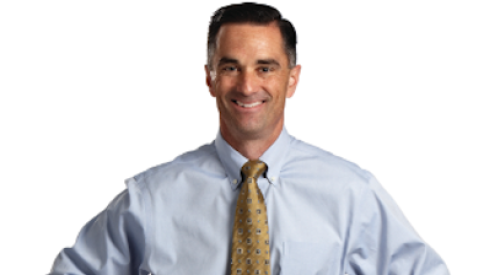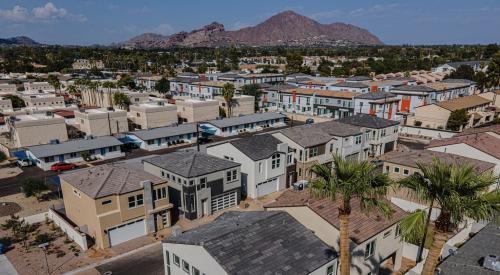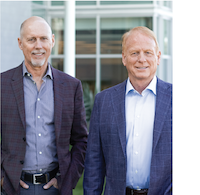
Mike Maples
Co-founders
Trumark Companies
San Ramon and
Newport Beach, Calif.
This is a longer version of an interview that appeared in the May/June 2020 issue of Pro Builder.
Trying to grow a large, private home building operation while competing against well-heeled publicly traded national companies is doable, as long as the search for investors and capital doesn’t wear you down. Some privates tap into additional capital by going public, while others secure access to financing by aligning with overseas companies looking for development and revenue opportunities in the U.S. Such was the case earlier this year when Daiwa House Group, of Osaka, Japan, acquired a 60% equity interest in builder/developer Trumark Companies, Pro Builder's 2018 Builder of the Year. Trumark’s co-founders, who used credit cards to finance land deals during the savings and loan crisis, talk about how the deal with Daiwa will affect their company’s next stage of growth.
PRO BUILDER: How did the Daiwa deal come about?
Gregg Nelson: We’re always looking for resources to enhance our equity in order to be more aggressive in our deal underwriting and enhance our acquisition success. We started talking to Daiwa about a year ago and it took about 11 months to go through the entire process. A sale wasn’t something we were looking for.
Mike Maples: It was a growing appreciation of each other. When Daiwa walked in the door on February 15, 2019, and said they wanted to buy our company, we said we’re not for sale and thanks for the visit. But as we talked more about what they were pursuing—they showed us their six-year plan, which was part of their 50-year plan-—their move was to invest a lot of their assets in the U.S. and grow.
PB: How well did the two companies align?
GN: When we met with Daiwa, there were a series of alignments that made this interesting. We could tell, as we had meetings with them, that we shared many of the same values. Daiwa talked a lot about how they care about their employees and how the employees are crucial to the company’s success. That was in line with how Mike and I view our company. People are our key asset, and we’ve been very fortunate to have high-caliber individuals and a culture of respect. So, culturally, there was good alignment. Integrity and the desire to grow were other big categories where we found alignment.
When we met with Daiwa, there were a series of alignments that made this interesting. We could tell, as we had meetings with them, that we shared many of the same values. —Gregg Nelson
MM: Our respective growth plans also aligned, so we started talking about how maybe Daiwa could buy a small piece of our company. As we talked together about our six-year plans and the amount of capital that would be best for that, and other lines of credit, Daiwa was motivated by that. But they were like, “If we’re going to put in this much for the line of credit, we’d like to have a controlling interest in the company.” That discussion took place over several months. So we went from “We’ll never do this,” to “This is kind of interesting,” and eventually to “Wow, this may really be advantageous.”
The main difference [in making the decision to sell a controlling interest] was that Daiwa wanted to come along with our team and grow it. Suddenly Gregg and I realized we’re not as young as we used to be, and if we ever got to the point where we sold to a U.S. company, they’d just take the assets, probably wipe out all of the people, and that would be the end. Gregg and I still want to run the company and put it on a good path for our people, and Daiwa [potentially offers] the magic formula for doing both of those things.
PB: How does Daiwa see the U.S. market?
GN: It’s very difficult to grow a company in Japan, given the country’s population and demographics. Daiwa sees the U.S. as a prime market for the future expansion of their business. So we look at this deal as combining our ability to operate here with the resources of one of the largest home builders in the world, in terms of their financial capability.
PB: Japanese companies have a reputation for a different work-life balance. Did you find that to be true?
MM: I would say our values align by our desire to introduce great product and communities and that we value our employees. There’s a different work-life balance in Japan—maybe not what it used to be, but certainly not the way it is in the U.S.
Also, we had a chance to talk with Steve Alloy [president of Stanley Martin Homes] about his experience [Daiwa acquired 82% of Stanley Martin Communities three years ago], and that gave us great insight. Steve was three years into it, so it wasn’t like he was still in the honeymoon period. He described the interaction and how Daiwa lets the [Stanley Martin] team run the company. That was really what made us feel comfortable.
Then we asked Steve what was it like for his company's working culture. The values of community-building ... but there wasn’t a shift to now you have to work 24/7, like the old rumors about Japanese work culture.
PB: What’s in Daiwa’s six-year plan?
MM: The six-year plan was more about the amount of capital they want to redeploy into the United States and how we fit in with that. There are a lot of opportunities they want to explore in the U.S., many of them with us, and a lot of our conversation revolved around those opportunities.
Daiwa said they like the variety of product types we do, and they do master planned communities, resort properties, home building, and pre-manufacture. So they like the fact that we've done urban and master plans, and that we have a focus now on mixed use, which blends our commercial expertise with where we think the market is going to go for commercial, retail, and residential. We think buyers like that; we think cities like that. Daiwa likes that we have these proven disciplines that they also like and we can begin to explore how we can do that together. That doesn’t mean they wouldn’t have other ventures, but they definitely want us to expand in other markets.
PB: Where else are you looking?
GN: Arizona and Sacramento. We’re also looking at areas in Nevada, Utah, the Northwest, Colorado ... We’re in the process of prioritizing.
PB: How will you export the collaborative company culture as you expand?
GN: One of the benefits with the partnership is the great reduction in friction surrounding financing our projects. That will be a huge change. As we look back at the past several years, if it weren't for that, we would be much larger than we are today. This does allow us to focus on higher priority objectives of growth and expansion, and with that comes the challenge of properly exporting our company culture to those markets or to new divisions. That’s a big part of where Mike and I are turning our focus now.
MM: We’ve had some great equity partners who helped us grow the business. They’ve been an important part of our history, but one of the challenges was always when we get a piece of property, we have to go through our due diligence to make sure it works, and then we have to get through [our partner's] due diligence. So, without having that double layer, it will save our staff a significant amount of time identifying equity partners and having to go through that due diligence that we ourselves already went through. When we make an offer, we know we can move quickly, and that’s a big advantage. It does free up a lot of our time to pursue other things that will actually grow the business.
I think, on the culture side, that it does help that 30 years ago we identified our work culture and our core competencies. We have been champions of that all these years. With expansion, it will be really important to cross-pollinate our culture into whatever the new market is and to make sure the company culture is all caught. Often, company culture is taught but not caught. So it's important to have it redefined and reinforced on a regular basis. We’re going to be looking at expansion in our own markets and in new markets.
There are a lot of opportunities [Daiwa] wants to explore in the U.S., many of them with us, and a lot of our conversation revolved around those opportunities. —Mike Maples
With equity partners, we had to look at every project only in the sense of what is best for the specific project and the specific equity person because that was our responsibility from a fiduciary standpoint. With the balance sheet going forward with Daiwa House, we can look at all of the projects combined and at what's best for the company, given the whole portfolio. In the past, sometimes those were in conflict with each other, and the ability to look at it holistically now will be advantageous going forward.
PB: With that kind of freedom, what type of projects will you pursue or do more of that you couldn’t do before because it wasn’t in your equity partners' best interests?
GN: As Mike pointed out, since we had to finance each project on its own merit, that focus wasn’t necessarily completely compatible with smooth, continuous company growth or for managing our resources from a corporate standpoint. For example, things can get lumpy when you try to find deals that can pass the underwriting criteria of your group of equity partners. There have been several times along the way when we looked at projects that maybe had thinner margin but would have really layered in nicely with some of the other projects in our pipeline. That's something our public peers look at all of the time, and with their financing structure they could do that.
It was always difficult for us to compete on those because we would take a deal with thinner metrics to the equity markets and get the cold shoulder a lot of times. They didn’t care about whether it was good for our business as a whole. They cared about whether it was good for them. So this allows us to be more balanced in our approach and to think about it more holistically from a business perspective.
MM: Another example would be how it might be better for a company to sell through a project faster and redeploy the capital. But our obligation to our capital partners was to maximize the value of that one particular neighborhood. So we can’t look at it holistically as to how it might benefit another part of the company by going quicker with a slightly lower sales price on that project. That’s what I mean by the holistic view also.
GN: One of the big advantages given that Daiwa is a Japanese-based company is they have access to money at a cheaper rate compared with the U.S. So it allows us to move forward and really take advantage of a low cost of funds, which will help us be compete against the public builders.
PB: You guys have come a long way from the early days when you were financing land deals with credit cards ...
MM: That’s right, Let’s just say this is more comfortable.
GN: Just slightly. Dealing with the stress is one thing when your age starts with a three, and a whole other thing when your age starts with a six.
PB: Mike, you mentioned previously that the Daiwa partnership enables Trumark to grow a multidiscipline platform. What does that mean?
MM: It’s mostly in the product type. We can do mixed commercial, urban. We can do all of the products we’ve historically done. Even if you go public, sometimes they want you to be more specific than that. Daiwa House is more opportunistic about growing those lanes.
PB: Are there aspects of Daiwa's approach Trumark will likely adopt?
MM: Yes there are. Obviously, Daiwa has this production mentality. We’ve seen their factory. It’s absolutely amazing, and we have done some early stages of that.
For example, we have this [TruFlex] townhouse project in Brea. Every townhouse is three stories, they’re all exactly the same box, and we worked very hard with all of the subcontractors to make sure the boxes are the same all the way through, so we can have late cut-off dates for all of the interior walls because all of the structural is on the outside. We panelize those off-site, so it’s kind of like the early stages of prefabbing. The walls come out and tilt up quickly on the foundation.
Our next [Truflex] project is in San Diego, and we’re going to put insulation board on the panels in the factory. We’re taking phases that can be done fairly easily on a manufactured basis. That box in Brea can be configured 24 different ways for the buyer. It’s remarkable. You don’t think you're walking into the same box as you walk from house to house. Each lives incredibly differently from the plan before.
As far as setting up factories in the U.S., to do everything off-site, that hasn’t been discussed in detail. —Mike Maples
As we refine it—maybe we’re giving the buyer too many choices—but it’s kind of a manufacturing mentality of figuring how can we simplify the process that gives you variety in the end. We have some redundancy in some of our plumbing trees, and we went to our subcontractors and said yeah, they’re going to be the same for every single house. You can produce your plumbing tree all at once. Maybe there’s a couple of extra fixtures on it, but we do them for all. We pre-do them for all of the options from the very beginning.
Same with electrical. All going into the same place in the walls. HVAC has been thought out ahead of time, so nothing moves around. So that should save us some cycle time on site. It should make it easier for the subcontractor. We hope as we prove it out that the subs will give us better pricing. That's some of the manufacturing mentality of the Japanese, and we hope as we visit more with them that we can learn more about that and the lessons they've learned.
As far as setting up factories in the U.S., to do everything off-site, that hasn’t been discussed in detail. I think we’ll just keep doing what we’ve been doing and see where that takes us.
GN: The off-site manufacturing process they use in Japan isn't completely portable to the U.S. There are different [fire] expectations there than there are here in terms of what materials are used and the architectural look, particularly the exterior of a building. The [off-site manufacturing] process is being pursued in the U.S. by independent companies, like framing contractors, that are looking to put together the structure of a building and then push beyond that.
What you see in Japan are completely assembled finished panels that can be assembled on site. I think that gap is going to close. What we’ve been doing with the TruFlex program is moving in that direction by being able to adapt the best of the technologies that are applicable from Japan and combine those with what we know works for the marketplace here. We’ll be able to pursue tremendous opportunities here.
